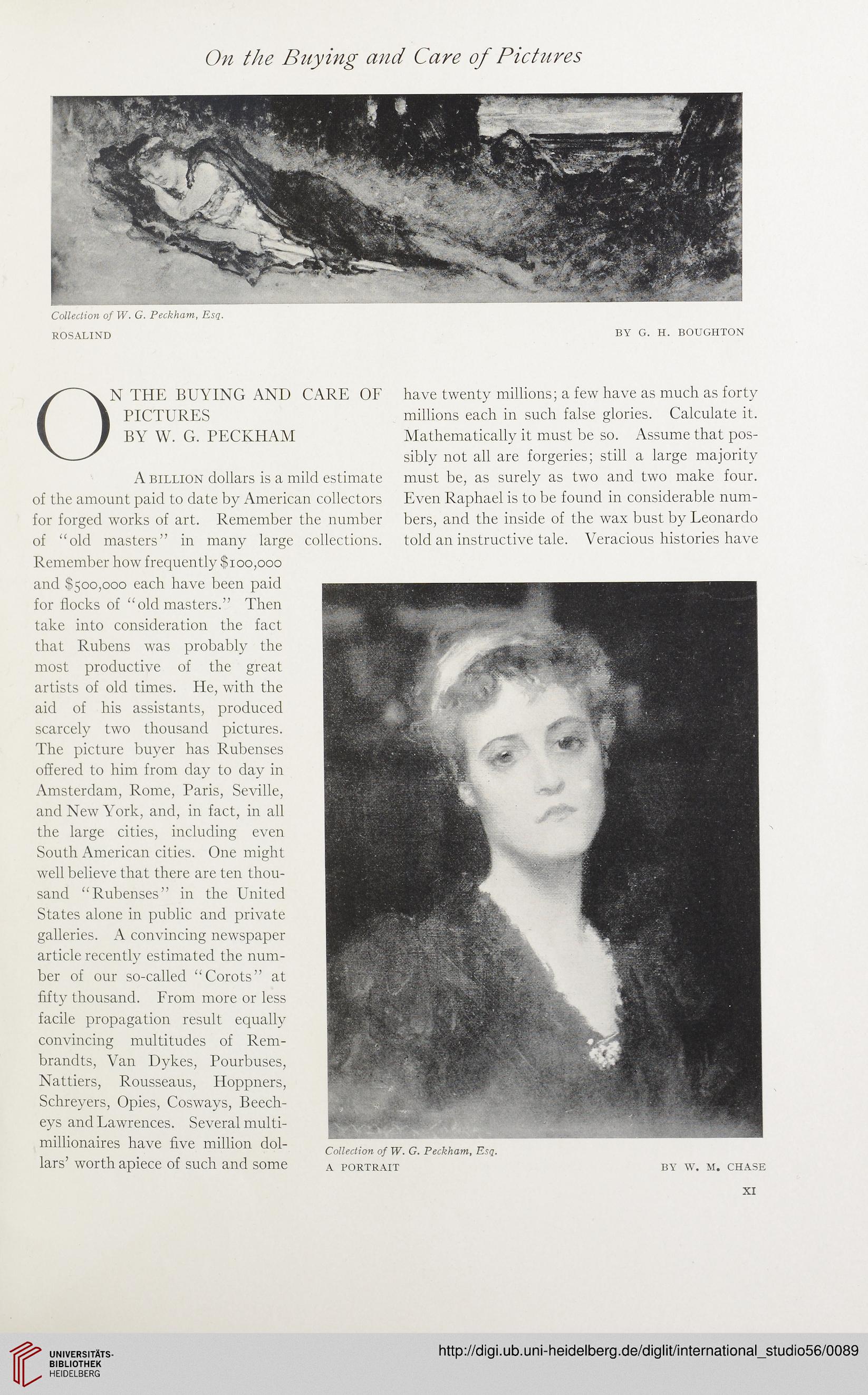On the Buying and Care of Pictures
Collection of W. G. Peckham, Esq.
ROSALIND
BY G. H. BOUGHTON
ON THE BUYING AND CARE OF
PICTURES
BY W. G. PECKHAM
A billion dollars is a mild estimate
of the amount paid to date by American collectors
for forged works of art. Remember the number
of “old masters” in many large collections.
have twenty millions; a few have as much as forty
millions each in such false glories. Calculate it.
Mathematically it must be so. Assume that pos-
sibly not all are forgeries; still a large majority
must be, as surely as two and two make four.
Even Raphael is to be found in considerable num-
bers, and the inside of the wax bust by Leonardo
told an instructive tale. Veracious histories have
Remember how frequently $100,000
and $500,000 each have been paid
for flocks of “old masters.” Then
take into consideration the fact
that Rubens was probably the
most productive of the great
artists of old times. He, with the
aid of his assistants, produced
scarcely two thousand pictures.
The picture buyer has Rubenses
offered to him from day to day in
Amsterdam, Rome, Paris, Seville,
and New York, and, in fact, in all
the large cities, including even
South American cities. One might
well believe that there are ten thou-
sand “Rubenses” in the United
States alone in public and private
galleries. A convincing newspaper
article recently estimated the num-
ber of our so-called “Corots” at
fifty thousand. From more or less
facile propagation result equally
convincing multitudes of Rem-
brandts, Van Dykes, Pourbuses,
Nattiers, Rousseaus, Hoppners,
Schreyers, Opies, Cosways, Beech-
eys and Lawrences. Several multi-
millionaires have five million dol-
lars’ worth apiece of such and some
Collection of W. G. Peckham, Esq.
A PORTRAIT BY W. M. CHASE
XI
Collection of W. G. Peckham, Esq.
ROSALIND
BY G. H. BOUGHTON
ON THE BUYING AND CARE OF
PICTURES
BY W. G. PECKHAM
A billion dollars is a mild estimate
of the amount paid to date by American collectors
for forged works of art. Remember the number
of “old masters” in many large collections.
have twenty millions; a few have as much as forty
millions each in such false glories. Calculate it.
Mathematically it must be so. Assume that pos-
sibly not all are forgeries; still a large majority
must be, as surely as two and two make four.
Even Raphael is to be found in considerable num-
bers, and the inside of the wax bust by Leonardo
told an instructive tale. Veracious histories have
Remember how frequently $100,000
and $500,000 each have been paid
for flocks of “old masters.” Then
take into consideration the fact
that Rubens was probably the
most productive of the great
artists of old times. He, with the
aid of his assistants, produced
scarcely two thousand pictures.
The picture buyer has Rubenses
offered to him from day to day in
Amsterdam, Rome, Paris, Seville,
and New York, and, in fact, in all
the large cities, including even
South American cities. One might
well believe that there are ten thou-
sand “Rubenses” in the United
States alone in public and private
galleries. A convincing newspaper
article recently estimated the num-
ber of our so-called “Corots” at
fifty thousand. From more or less
facile propagation result equally
convincing multitudes of Rem-
brandts, Van Dykes, Pourbuses,
Nattiers, Rousseaus, Hoppners,
Schreyers, Opies, Cosways, Beech-
eys and Lawrences. Several multi-
millionaires have five million dol-
lars’ worth apiece of such and some
Collection of W. G. Peckham, Esq.
A PORTRAIT BY W. M. CHASE
XI




